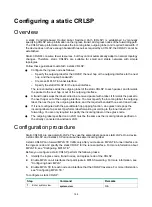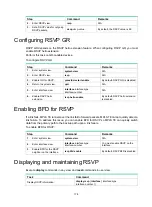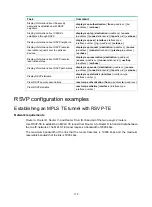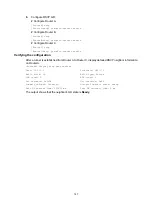
173
by sending back a message that includes the Message_ID_ACK object. If the sender does not
receive a Message_ID_ACK within the retransmission interval (Rf), it performs the following tasks:
•
Retransmits the message when Rf expires.
•
Sets the next transmission interval to (1 + delta) × Rf.
The sender repeats this process until it receives the Message_ID_ACK before the retransmission
time expires or it has transmitted the message three times.
RSVP authentication
RSVP authentication ensures integrity of RSVP messages, and prevents false resource reservation
requests from occupying network resources.
With RSVP authentication, the sender uses the MD5 algorithm and the authentication key to
calculate a message digest for an RSVP message, and inserts the digest to the RSVP message.
When the receiver receives the message, it performs the same calculation and compares the result
with the message digest. If they match, the receiver accepts the message. Otherwise, it drops the
message.
By carrying a sequence number in a message, RSVP authentication can also prevent packet replay
attacks. The device records the sequence number of a received RSVP message, and determines
whether the subsequent messages are valid according to the recorded sequence number. If the
sequence number of a subsequent message is within the valid range, the device accepts the
message. Otherwise, it drops the message.
RSVP GR
RSVP Graceful Restart (GR) preserves soft state and label forwarding information when the
signaling protocol or control plane fails, so that LSRs can still forward packets according to
forwarding entries.
RSVP GR defines the following roles:
•
GR
restarter
—Router that gracefully restarts due to a manually configured command or a fault.
It must be GR-capable.
•
GR
helper
—Neighbor of the GR restarter. A GR helper maintains the neighbor relationship with
the GR restarter and helps the GR restarter restore its LFIB information. A GR helper must be
GR-capable.
The device can act only as a RSVP GR helper.
The RSVP GR feature depends on the extended hello capability of RSVP. A GR-capable device
advertises its GR capability and relevant time parameters to its neighbors in RSVP hello packets. If a
device and all its neighbors have the RSVP GR capability and have exchanged GR parameters,
each of them can function as the GR helper of another device.
A GR helper considers that a GR restarter is rebooting when the number of consecutive lost hellos or
erroneous hellos reaches the value configured by the
hello lost
command. When a GR restarter is
rebooting, the GR helpers perform the following operations:
•
Retain soft state information about the GR restarter.
•
Continue sending hello packets periodically to the GR restarter until the restart timer expires.
If a GR helper receives a hello message from the GR restarter before the restart timer expires, the
recovery timer is started and signaling packet exchange is triggered to restore the original soft state.
Otherwise, all RSVP soft state information and forwarding entries relevant to the neighbor are
removed. When the recovery timer expires, soft state information and forwarding entries that are not
restored are removed.
















































